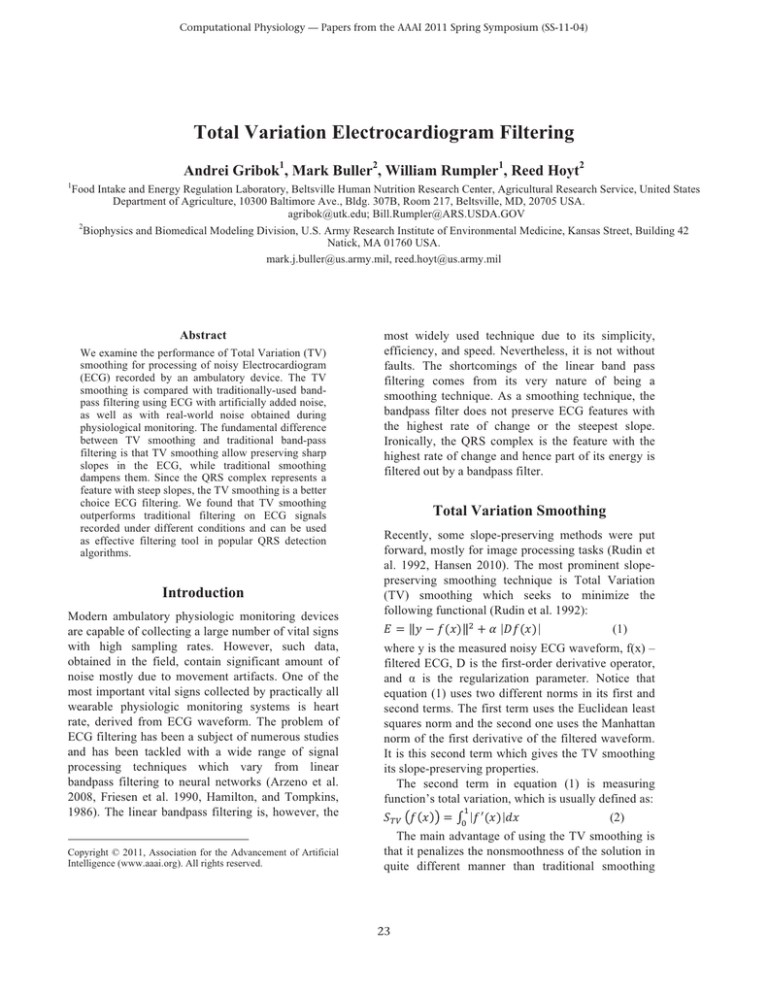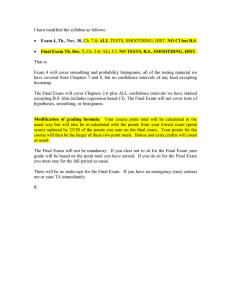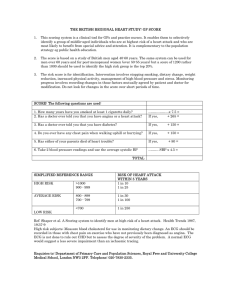
Computational Physiology — Papers from the AAAI 2011 Spring Symposium (SS-11-04)
Total Variation Electrocardiogram Filtering
Andrei Gribok1, Mark Buller2, William Rumpler1, Reed Hoyt2
1
Food Intake and Energy Regulation Laboratory, Beltsville Human Nutrition Research Center, Agricultural Research Service, United States
Department of Agriculture, 10300 Baltimore Ave., Bldg. 307B, Room 217, Beltsville, MD, 20705 USA.
agribok@utk.edu; Bill.Rumpler@ARS.USDA.GOV
2
Biophysics and Biomedical Modeling Division, U.S. Army Research Institute of Environmental Medicine, Kansas Street, Building 42
Natick, MA 01760 USA.
mark.j.buller@us.army.mil, reed.hoyt@us.army.mil
Abstract
We examine the performance of Total Variation (TV)
smoothing for processing of noisy Electrocardiogram
(ECG) recorded by an ambulatory device. The TV
smoothing is compared with traditionally-used bandpass filtering using ECG with artificially added noise,
as well as with real-world noise obtained during
physiological monitoring. The fundamental difference
between TV smoothing and traditional band-pass
filtering is that TV smoothing allow preserving sharp
slopes in the ECG, while traditional smoothing
dampens them. Since the QRS complex represents a
feature with steep slopes, the TV smoothing is a better
choice ECG filtering. We found that TV smoothing
outperforms traditional filtering on ECG signals
recorded under different conditions and can be used
as effective filtering tool in popular QRS detection
algorithms.
Introduction
Modern ambulatory physiologic monitoring devices
are capable of collecting a large number of vital signs
with high sampling rates. However, such data,
obtained in the field, contain significant amount of
noise mostly due to movement artifacts. One of the
most important vital signs collected by practically all
wearable physiologic monitoring systems is heart
rate, derived from ECG waveform. The problem of
ECG filtering has been a subject of numerous studies
and has been tackled with a wide range of signal
processing techniques which vary from linear
bandpass filtering to neural networks (Arzeno et al.
2008, Friesen et al. 1990, Hamilton, and Tompkins,
1986). The linear bandpass filtering is, however, the
Copyright © 2011, Association for the Advancement of Artificial
Intelligence (www.aaai.org). All rights reserved.
most widely used technique due to its simplicity,
efficiency, and speed. Nevertheless, it is not without
faults. The shortcomings of the linear band pass
filtering comes from its very nature of being a
smoothing technique. As a smoothing technique, the
bandpass filter does not preserve ECG features with
the highest rate of change or the steepest slope.
Ironically, the QRS complex is the feature with the
highest rate of change and hence part of its energy is
filtered out by a bandpass filter.
Total Variation Smoothing
Recently, some slope-preserving methods were put
forward, mostly for image processing tasks (Rudin et
al. 1992, Hansen 2010). The most prominent slopepreserving smoothing technique is Total Variation
(TV) smoothing which seeks to minimize the
following functional (Rudin et al. 1992):
(1)
where y is the measured noisy ECG waveform, f(x) –
filtered ECG, D is the first-order derivative operator,
and α is the regularization parameter. Notice that
equation (1) uses two different norms in its first and
second terms. The first term uses the Euclidean least
squares norm and the second one uses the Manhattan
norm of the first derivative of the filtered waveform.
It is this second term which gives the TV smoothing
its slope-preserving properties.
The second term in equation (1) is measuring
function’s total variation, which is usually defined as:
(2)
The main advantage of using the TV smoothing is
that it penalizes the nonsmoothness of the solution in
quite different manner than traditional smoothing
23
ECG,normalized
ECG,normalized
techniques. Specifically, the TV penalty does not
depend on the steepness of the slope, thus allowing
sharp edges into the filtered signal. On the other
hand, the TV smoothing is still a low pass filter,
which effectively filters out high-frequency noise.
Results
We compared the performance of the TV filtering
with a commonly used Butterworth bandpass filter
with the pass band between 5 and 15 Hz. Figure 1
shows an example of applying TV and Butterworth
filtering to a triangular impulse contaminated with
noise.
As can be seen in Fig.1, the Butterworth filter
significantly attenuated the peak of the impulse and
also introduced sidelobe artifacts, which are not
present in the original signal. These undesirable
effects can significantly complicated peak detection
and leak to missed or spurious peaks.
1
Triangular pulse function
Butterworth band-pass smoothing
TV smoothing
f(t)
0
-0.15
-0.1
-0.05
0
t
0.05
0.1
0.15
Figure 1 Comparison of TV and Butterworth filtering
for a triangular impulse
In contrast, the TV filtering preserved most of the
peak’s energy and also showed no sidelobe artifacts,
thus leading to a filtered signal with better signal-tonoise-ratio.
The same observation can be made while using the
TV smoothing for a real ECG recoding. Figure 2
shows a small portion of an ECG recording obtained
in ambulatory conditions using Equivital physiologic
monitoring system (Hidalgo Limited, UK). The
monitor is an FDA-approved complete human
physiological
monitoring
platform,
allowing
measurements of human physiology in both
laboratory based and field research. The chest worn
ambulatory monitor device provides real time
measurements of core temperature, skin temperature,
heart rate, respiratory rate, and physical activity. On
these data, as well, the TV smoothing demonstrates
its superior edge-preserving properties in comparison
with Butterworth filtering.
0
-0.1
0
50
100
150
200
250
300
350
400
450
0.2
0
-0.1
0
50
100
150
200
250
300
Sample #
350
400
450
However, the ECG filtering is usually only the
initial step in the ECG processing, which is aimed at
QRS detection and beat time identification.
To validate the TV smoothing, we modified and
customized a well-known algorithm (Pan, and
Tompkins 1985) to fit the needs of our perspective
applications. In the first stage, the algorithm uses a 5to 15-Hz Butterworth band-pass filter to eliminate
non-QRS-related frequencies, and in the second
stage, it computes the difference between two
consecutive points to amplify the sharp slopes of the
QRS complex. After differencing, it squared the
resulting signal to make the ECG samples positive
and to amplify the high-frequency components.
Finally, in the last stage, it uses a low-pass filter to
enhance the fiducial marks of the QRS complex and
implements a self-adaptive thresholding method to
detect QRS peaks, reject noise, discriminate T-waves,
and search back for missed QRS complexes if a
detection was not made within a certain time interval
Our modification concerned only the first stage of
the algorithm, namely, we replaced the Butterworth
filter with TV smoothing leaving the rest of the
algorithm unchanged. Consequently, we compared
the performance of the original algorithm with the
one that uses the TV smoothing. The comparison was
performed on the ECG waveform collected during
the study on glycemic control in young adults
performed at the USDA Beltsville Human Nutrition
Center. The study has been approved by the IRBs of
all participating institutions. The first set of tests
consisted in selecting a very clean ECG segments and
their subsequent contamination with Gaussian white
noise of different intensities. By adding Gaussian
noise with different standard deviations, different
signal-to-noise (S/N) ratios have been simulated. A
total number of 100 one-minute long ECG segments
have been selected and, after adding Gaussian noise,
was processes by the previously described QRSdetection algorithm. The performance of the
algorithms implementing TV smoothing and
24
500
Raw ECG
TV smoothing
0.1
Figure 2 Application of Butterworth band-pass
filtering (top panel) and TV (bottom panel)
smoothing to a real ECG signal.
0.5
-0.5
-0.2
Raw ECG
Butterworth smoothing
0.1
500
Butterworth filtering has been compared in terms of
Root Mean Squared Error (RMSE) between the
instantaneous heart rates (HR) obtained from noisecontaminated ECG and original clean ECG. The
RMSE was defined as the square root of the mean
squared difference between the estimated and the
ground-truth HRs after both HRs had been resampled
to 1 Hz via linear interpolation. The average RMSE
for 100 segments was estimated and the results for
four different S/N ratios are summarized in Table 1.
As can be seen from Table 1, the TV smoothing
consistently outperform the Butterworth filtering in
terms of RMSE.
S/N
10
5
3
1
RMSE,
bpm,
Butterworth
RMSE,
bpm
TV
0.20
0.25
0.29
44.30
Real
World
2.12
0.15
0.20
0.21
17.30
0.51
Table 1 Comparison of Butterworth filtering and TV
smoothing for different signal-to-noise ratios and for
the real-world noise contamination.
0.1
Discussion and Conclusions
The TV smoothing provides a powerful edgepreserving smoothing technique, which compares
favorably with tradition band-pass filtering used in
ECG preprocessing. The TV smoothing consistently
outperformed the Butterworth band-pass filter in our
test using artificially-generated, as well as, real world
noise. The power of TV smoothing comes from its
ability to preserve sharp gradients in the signal, thus
allowing for the QRS complexes to pass through
filtering process relatively undistorted. The frequency
response of the Butterwoth filter and TV smoothing
is shown in Fig. 4. Notice, while the TV smoothing
performs as a band-pass filter, it preserves more highfrequency information, which is evident form the fact
that the solid black line is higher in every frequency
range. The TV smoothing has only one parameter to
select: α in (1). This parameter is equivalent to
selection of the pass band for the liner filter. The
higher the parameter, the more high-frequency
information is removed from the filtered signal. In
this study, we used the discrepancy principle
(Morozov, 1993) to select the parameter, since the
noise level in the ECG could be reasonably-well
estimated. Also, in contrast to other edge-preserving
filtering techniques, the TV smoothing does not
require the knowledge of edge locations, which can
be impossible to determine in real-life applications.
Similar to linear filtering, the TV smoothing has
Bayesian interpretation, it assumes that the sought
solution has Laplace distribution, in contrast to
traditional filtering, which assumes Gaussian
distribution.
Raw ECG
10
0.05
-5
Butterworth filter
TV smoothing
0
-0.05
10
ECG, channel 2
500
1000
1500
2000
2500
3000
3500
PSD,mVolt2/frequency
ECG,channel 1
The second test was performed using the realworld noise found in the ECG recordings. The
Hidalgo system uses a two channel ECG recording
for redundancy and more reliable measurements. In
some ECG segments, one ECG channel was found to
be noise-contaminated, while the other one was noise
free, as demonstrated in Fig. 3. We selected 100 such
segments and used the noise-free channel to calculate
the ground truth heart rate while the noisy channel
was used to test the algorithms.
obtained using the TV smoothing is more than four
time smaller than the corresponding band-pass filter
RMSE.
4000
Raw ECG
0.1
0
-0.1
500
1000
1500
2000
2500
3000
3500
4000
Sample #
Figure 3 An example of two-channel ECG segment
with channel one (top panel) contaminated with noise
and channel two (bottom panel), noise free. Such
segments were used to compare two algorithms in the
presence of real-world noise.
The average RMSE for the 100 segments was
calculated and the results are presented in the last
column of Table 1. As we can see, the RMSE
10
10
10
10
-6
-7
-8
-9
-10
0
20
40
60
80
100
120
Frequency,Hz
Fig. 4 Frequency response of TV smoothing (solid)
and Butterworth filter (dashed).
One of the disadvantages of the TV smoothing is
that there is no closed-form solution to minimize (1).
25
However, the recent advances in the numerical
implementation of TV algorithms made them
computationally competitive with traditional liner
filters. In this work we used the TV algorithm
described in (Little, Jones 2010).
Disclaimer
The opinions and assertions contained herein are the
private views of the authors and are not to be
construed as official or as reflecting the views of the
U.S. Army or of the U.S. Department of Defense.
This paper has been approved for public release with
unlimited distribution.
References
Arzeno, N., M. Deng, Z. D., and Poon, C. S. 2008.
Analysis of first-derivative based QRS detection
algorithms. IEEE Trans Biomed Eng, vol. 55, pp. 478-484.
Friesen, G. M., Jannett, T. C., Jadallah, M. A. S., Yate, L.,
Quint, S. R., and Nagle, H. T. 1990. A comparison of the
noise sensitivity of nine QRS detection algorithms. IEEE
Trans Biomed Eng, vol. 37, pp. 85-98.
Hamilton, P. S., and Tompkins, W. J. 1986. Quantitative
investigation of QRS detection rules using the MIT/BIH
arrhythmia database. IEEE Trans Biomed Eng, vol. 33, pp.
1157-1165.
Pan, J., and Tompkins, W. J. 1985. A real-time QRS
detection algorithm. IEEE Trans Biomed Eng, vol. 32, pp.
230-236.
Rudin, L.I., Osher, S., Fatemi, E. 1992. Nonlinear total
variation based noise removal algorithms. Physica D, vol.
60, pp. 259–268.
Hansen, P. 2010. Discrete Inverse Problems: Insight and
Algorithms (Fundamentals of Algorithms), SIAM,
Philadelphia
Little, M.A., Jones, N.S. 2010. Sparse Bayesian StepFiltering for High-Throughput Analysis of Molecular
Machine Dynamics in 2010 IEEE International Conference
on Acoustics, Speech and Signal Processing, 2010.
ICASSP 2010 Proceedings.: Dallas, TX, USA (in press)
Morozov, V. A. 1993 Regularization Methods for Ill-Posed
Problems. Florida: CRC Press,.
26








